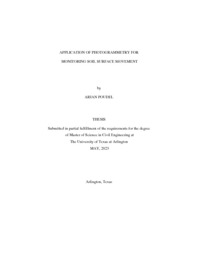
ATTENTION: The works hosted here are being migrated to a new repository that will consolidate resources, improve discoverability, and better show UTA's research impact on the global community. We will update authors as the migration progresses. Please see MavMatrix for more information.
Show simple item record
| dc.contributor.advisor | Yu, Xinbao | |
| dc.creator | Poudel, Arjan | |
| dc.date.accessioned | 2023-06-14T17:07:15Z | |
| dc.date.available | 2023-06-14T17:07:15Z | |
| dc.date.created | 2023-05 | |
| dc.date.issued | 2023-05-19 | |
| dc.date.submitted | May 2023 | |
| dc.identifier.uri | http://hdl.handle.net/10106/31270 | |
| dc.description.abstract | Understanding slope behavior and forecasting failure requires accurate soil surface movement measurements. Research gaps and constraints remain despite the development of diverse methods. Recently, photogrammetry has become a promising method for detecting soil surface movement. This method involves setting coded targets and ground points on the soil surface, taking photographs before and after the movement, and using photogrammetric software to measure accurately. However, past studies have mostly used high-end cameras with excellent resolution and geotagging, which may not have been available in all contexts. Thus, this study compares the accuracy and precision of geotechnical soil surface measurement with a consumer-grade DSLR camera. The study shows how photogrammetry with a consumer-grade camera can measure soil surface movement.
This paper presents a study in which photogrammetry was used to measure heave in clayey soil during a pullout test in the lab. The study details the procedures involved in the test, including the placement of the targets and the use of digital dial gauges to obtain measurements. The results show that the photogrammetric approach was successful in obtaining accurate and consistent measurements of heave. This information can be valuable in understanding the behavior of the soil under different conditions and aid in predicting potential soil heave.
In addition, this study also applied photogrammetry in the field to monitor the movement of a particular slope over a period of several months. A 3D model of the slope was built by processing images captured using a consumer-grade camera, and reliable accuracy was achieved. Ground points were observed over a period to monitor the slope. The field results showed that there was no significant movement in the slope during the three-month observation period. The successful application of photogrammetry in this field test demonstrates its potential as a valuable tool for monitoring and analyzing soil surface movement in natural environments. | |
| dc.format.mimetype | application/pdf | |
| dc.language.iso | en_US | |
| dc.subject | Photogrammetry | |
| dc.subject | Heave measurement | |
| dc.subject | Slope monitoring | |
| dc.title | Application of Photogrammetry for Monitoring Soil Surface Movement | |
| dc.type | Thesis | |
| dc.date.updated | 2023-06-14T17:07:15Z | |
| thesis.degree.department | Civil Engineering | |
| thesis.degree.grantor | The University of Texas at Arlington | |
| thesis.degree.level | Masters | |
| thesis.degree.name | Master of Science in Civil Engineering | |
| dc.type.material | text | |
Files in this item
- Name:
- POUDEL-THESIS-2023.pdf
- Size:
- 5.745Mb
- Format:
- PDF
This item appears in the following Collection(s)
Show simple item record


